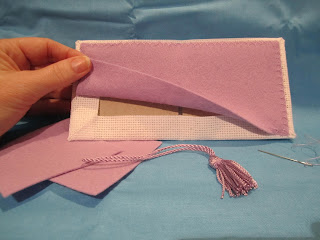Quite a few years ago when my children were very small, I thought it would be a lovely sentiment to make a couple of 'extra special' decorations that would be given pride of place in the home, hold 'extra special' meaning and which could be passed down as heirlooms. This 'Merry Christmas' cross stitch is one such heirloom which always hangs in our front foyer and with its colourful design mix makes for a beautiful welcome which has received many favourable comments over the years. Unfortunately, the details of the design have been misplaced and cannot remember who the designer is, but I do know it was an enjoyable challenge to stitch. This photograph doesn't do it justice (the glass prevented clarity) so I have posted a couple of closer shots below to give a better idea of the design as well as the embellishments used.
I'm not quite sure really which letter I prefer because there's uniqueness in each one and no two letters are alike but the quirkiness of the design, even to this very day, has me spending time poring over it each year when it's unwrapped and ready for hanging. But what's really special is that my daughter loves it so much that she's asked for it to be passed down to her in years to come. Of course, that was always my intention.
But the heirloom which I intend to pass down to my son - a wooden Christmas wreath - was painted when I was studying folk art and as a young boy he was fascinated with the brightly coloured toy ornaments. He laid claim to this when I personalised it by putting his birth year on the train. It hangs proudly in our kitchen against the pantry and attests to the many, many, many time consuming but rewarding hours devoted to painting each and every design.
I would like to take this opportunity to wish everyone a very Merry Christmas with family and friends and a safe and happy New Year and look forward to sharing more of my projects and encounters with nature with my readers and talking 'stitchy' talk in 2014.
Ros
'The best thing about the future is that it comes only one day at a time' - Abraham Lincoln




































